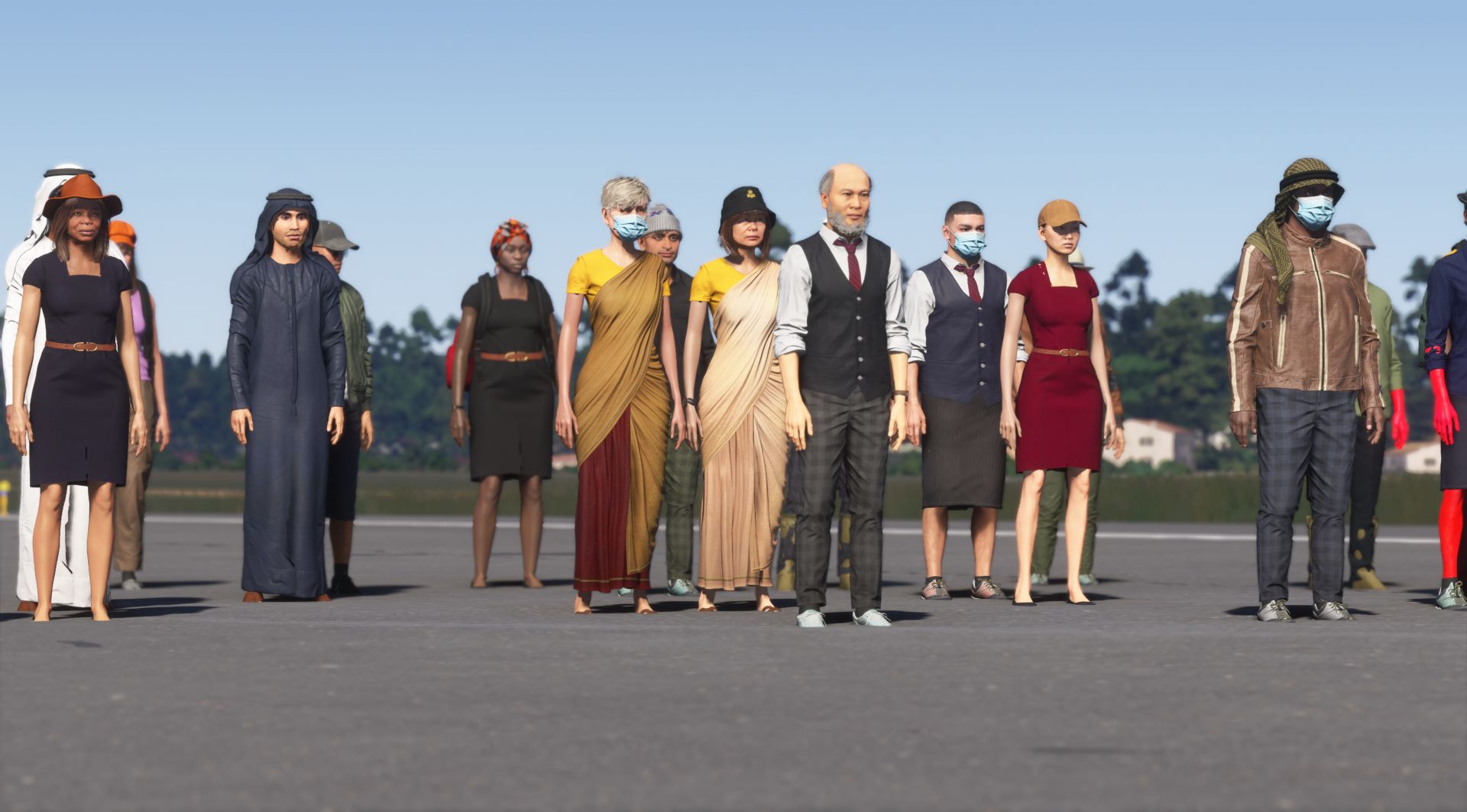Last week, I enjoyed a few hours with Microsoft Flight Simulator 2024 during a preview event in Arizona, United States, and I can finally share my impression of this brand-new chapter of the storied flight simulation franchise.
The first thing you’ll likely do when starting the simulator for the first time is create a character. While there are many presets to choose from if you’d rather not spend too much time on this, there are also tons of options to make your pilot truly yours.
An appearance section lets you choose your face, body type, hair, and voice. Many ethnicities and styles are available, and interestingly, you’ll also be able to record your own voice so that your pilot will speak with it. Unfortunately, I did not have a microphone available, so I was not able to test this, but it’s certainly intriguing.
The apparel section is no less rich, including eyewear, tops, legwear, footwear, and uniforms, to truly set your own style.
On top of your pilot, you can also select your copilot, and this time around, they will be visible in their seat if you look at them, unlike Microsoft Flight Simulator 2020, which featured an empty copilot seat.

While the previous simulator was already beautiful, Asobo has pulled all the stops to make Microsoft Flight Simulator 2024 even more visually attractive, and the jump in fidelity is absolutely impressive, especially when you look at the environment.
Vegetation has been revolutionized. Trees come in many different species and sizes, appropriate for each biome (and there are plenty of different biomes), while the grass is much more beautiful and realistic.
The rendering of the ground has also been changed to include complex displacement mapping that really “sells” the visuals of rocks, soil, and gravel. On top of that, rivers and roads are much better defined compared to MSFS 2020.
There are even small but delightful details like tire tracks in the grass or snow when you land or taxi outside of a paved surface. Everything is then enriched by seasonal variation, which looks really charming.
If that wasn’t enough, photogrammetry has been used for certain relevant natural environments, like the Grand Canyon, increasing the visual fidelity even further. Unlike urban photogrammetry, which is hit-and-miss, the tech proves especially effective in portraying organic materials like rock and dirt.

Speaking of urban photogrammetry, this is probably the only point of criticism I have for the visuals of the new simulator. There is a lot of variation in fidelity depending on the resolution and quality of the source material.
While this isn’t necessarily Microsoft’s fault, it’s obvious that there is still a lot of room for improvement in this area, albeit the flaws are only visible if you fly really low and slow. If you fly higher and faster, the cities that are represented with photogrammetry certainly appear much more fetching.
Some of the photogrammetry data has been brought pretty much 1:1 from Microsoft Flight Simulator 2020, at least in the build I tried. For example, Tokyo is very outdated, using data from 2014. How do I know? I was there when it was shot, and the massive Destiny billboard on the facade of Sofmap in Akihabara is still there.
There are no new hand-crafted airports in Microsoft Flight Simulator 2024, and the explanation is pretty simple: Microsoft Flight Simulator 2020 already had a massive quantity of them thanks to the free world and city updates.
Microsoft opted to include them all (from 150 in the standard edition to 160 in the Premium Deluxe Edition) and improve them, and the improvements in the airports I’ve seen are quite impressive.

One of the biggest changes is the precision of ground markings, which were quite blurry in the previous sim, while they are crisp and beautifully defined in the new one. You won’t have to struggle anymore to read whether a stop bar is marked “A330” or “A320.”
On top of that, Asobo and its partners created massive numbers of glider airfields, helipads, and oil rigs. Massive research went into this, and the developer believes all have been reproduced in the sim. Incidentally, the oil rigs will be periodically updated to reflect real-world movement (yes, they do move).
We also get realistic obstacles like towers and electricity poles correctly mapped all over the world. Of course, these aren’t just visual changes, as they massively affect how you fly, especially if you do so visually.
Yet, one of the biggest changes is more subtle, and it’s the lighting. Asobo used photometric lighting to make the intensity and temperature of the light more realistic both during the day and during the night.
This impacts everything, from the environment to the sky. Lighting is incredibly important to the looks of a video game, and Microsoft Flight Simulator 2024 is no exception. Its predecessor already had advanced lighting, but we are in a whole different league here.

Speaking of the sky, it has been enriched considerably by the addition of cirrus clouds, so the result is much closer to what you may see simply looking out of the window.
Incidentally, the live weather feature of the simulator also received a massive upgrade with the ability to “rewind” the time back up to 24 hours in a sort of mini-historical weather. That way, you can fly with real weather from earlier in the day or even the night before, and relive relevant storms or similar events.
Basically, Microsoft’s “digital twin” of Earth has evolved massively, to the point that many areas aren’t far off from the visual fidelity you can expect from a first or third-person open-world survival game nowadays, despite the massive difference in scale, which is very impressive.
The developers didn’t just pay attention to the world, but also to its inhabitants. Human models appear with accurate ethnicities and appropriate clothes in every area of the world. The variety has also been massively improved, and when you fly from one country to the other, passengers will reflect both in their looks. Some will even speak the appropriate languages.
Moving on to animals, Microsoft actually acquired all the animal models from Frontier Developments’ Planet Zoo, resulting in much more fetching fauna with a massive variety as you explore different areas of Earth.
While they’re not exactly “alive” but they’re at least dynamic, cars and ships have also been improved considerably in their looks, and there are hundreds of different models that you’ll see in the world.

Air traffic (this is a flight simulator, after all) is likely what received the most radical changes. Gone are the times of a few Frankenstein aircraft with fictional (and horrible) liveries to represent the world’s airlines. The developers have reproduced 91% of the world’s civilian aircraft as AI models.
There is still room for improvement with liveries, as Microsoft managed to reproduce 25% of the existing airlines for the moment. Of course, more will come with updates.
The one point of criticism I have for AI air traffic (at least for now) is that MSFS 2024 still uses data from FlightAware to drive its live AI aircraft. In my experience, that’s pretty lacking, especially in certain areas of the world. FlightRadar 24 tends to have better and much more complete data, and I wish it was chosen as the partner, or even better, I wish Microsoft used both and integrated them so that we could enjoy the best of both worlds.
AI traffic is extremely important for immersion, especially at airports, and it’s great to see that improvements have been made, reducing the requirement for third-party add-ons. Yet, I hope to see further steps down the line.
The visual evolution of the flyable aircraft isn’t as radical as that of the world, considering that they were already fantastic in the previous simulator. That being said, the difference is still rather striking mostly thanks to the much-improved lighting and the addition of ray-traced shadows.
Another element that has been improved is the scratches on the windshields, which are now much more realistic, especially when the light filters through them. Speaking of windshields, unlike MSFS 2020, the wipers are now functional.

While the models haven’t changed as radically as the rest of the planet, you can now appreciate them much better thanks to the ability to walk around the aircraft and perform pre-flight inspections, like a real pilot. Especially, this is great to convey the aircraft’s scale, which was much more difficult to perceive in the previous sim.
You can also open and close doors and hatches, which never hurts when you’re inspecting a beautiful aircraft, and quite simply to enhance immersion, alongside chocks and intake covers that react dynamically to the wind and have to be removed before flight.
Of course, the quality of the simulator is far from dependent exclusively on its visuals, and a lot of work has been done to improve physics, systems, and aerodynamics.
Some of these elements are actually interconnected with the visuals. For example, the ground handling of aircraft now feels much more natural and precise, and that’s also thanks to the much more realistic rendering of the ground itself which contributes to improved interaction with the tires.
While I am not a pilot, so I can’t pass final judgment on the accuracy of the flight models, I can certainly say that all the aircraft I tried feel much more dynamic and “alive” compared to their counterparts in Microsoft Flight Simulator 2020.
You can almost perceive the elasticity of the airframe as it glides through the airflow, and this really makes me wish for Force Feedback controls, which unfortunately are rare for flight simulators nowadays.

I actually tried flying the A-10 fast and low in the Grand Canyon, and it was a wild ride, with the winds and buffeting shaking me around and making the experience suitably challenging. It felt much closer to what I expected compared to the same endeavor in MSFS 2020.
Asobo highly boosted its tools to measure acceleration and physical interactions of real airframes, and used this telemetry to include in their flight models many more elements that they weren’t able to measure before, matching objective and scientific data with the subjective impressions from real pilots and instructors. The effect is very impressive.
The systems simulation has also been made much deeper in default aircraft, including electrical, hydraulic, pneumatic, fuel systems, and more out of the box.
There is even a wear and tear system that will simulate the aging of an airframe and the way you treat it. If you’re too rough on landing too many times or push your engine too far, your aircraft will suffer.
Accompanying the deeper systems simulation is advanced avionics simulation. MSFS 2024 includes over 10 cockpit systems simulated in great detail (and they’re available for third-party developers as well, which is great).

On the smaller side, these include the Garmin GNS 530, G1000 NXI, G3X Touch, and G3000, the Collins Pro Line 21, the Honeywell Primus Epic 2.0, and the Universal UNS-1 FMS.
On the airliner side, we got the Boeing 737 MAX 8 that adds to the 787 and 747-8i and appears to be simulated in quite some depth from the time I had to spend with it. On top of that, we also get the Boeing 747-400 LCF Dreamlifter, which means that we have detailed 747-400 avionics in the simulator. That’s not even all, considering that there is the Airbus side as well.
Interestingly, the developers even went as far as simulating the position of the satellites in orbit, influencing the workings of the GPS in your avionics suite.
The variety of aircraft simulated is staggering, with 70 different airframes in the Standard Editon, 80 in the Deluxe Edition, and 95 in the Premium Deluxe Edition. There is even an Aviator Edition that includes all the DLC aircraft published by Microsoft for MSFS 2020, for a total of 125.
You go from small general aviation aircraft to business jets, airliners, and freight aircraft, a few (unarmed) military aircraft, helicopters, gliders, and even more “out there” specimens like a hot air balloon, an airship, a paraglider, and more. Whatever flavor of aviation you enjoy, this sim has something for you.

A really interesting addition to Microsoft Flight Simulator 2024 is the career mode, which provides an element of progression and objectives to the otherwise open-ended simulator.
Of course, you’ll be entirely able to fly freely everywhere in the world on every aircraft you want, but the career mode basically mixes tutorials with a campaign.
It prompts you to choose whatever airport in the world you enjoy as a starting location, and the attention to detail is quite impressive. I picked Chofu near Tokyo, and I certainly did not expect to find signs in Japanese and a Japanese instructor welcoming me, and yet, that’s exactly what I found.
After you have picked your base, you’ll engage in a branching path of instruction flights, certification exams, and missions that will let you experience basically every area of aviation you can think of.
Of course, you’re not stuck at your starting airport, but you can also move to new bases for a change of environment and airspace.

One really smart implementation is the integration of tutorials within the career in the form of instruction flights. Many tend to skip tutorials, but in Microsoft Flight Simulator 2024, they feel like they’re “part of the game” and of your personal aviation story so I expect them to be a lot more popular than usual.
There is even a managerial aspect, allowing you to earn money, purchase new aircraft, and manage your fleet to tackle a wider variety of jobs.
Unfortunately, I didn’t have the time to go very deep into the career, but what I saw was really enjoyable, and I expect that unlocking and experiencing all the branches will keep even the most dedicated pilots busy for a long time. I was told that the game includes between 2 and 3 million missions. That’s a lot.
I described a lot of complex features in this preview, but those who aren’t hardcore flight simulation enthusiasts don’t need to worry. Like its predecessor, Microsoft Flight Simulator 2024 includes a full suite of assistance features that make flying very accessible, even more so when paired with some of the simpler aircraft.
This is definitely a sim for everyone, from the digital tourist who just wants to explore the world to the most hardcore simmers, passing by all levels of experience and realism requirements.

While the we’ll see its full scope only at release, I have few doubts that Microsoft Flight Simulator 2024 is the most advanced, complex, and full-featured flight simulator ever created (at least among these you can buy at price affordable to most), and at the same time, it’s likely the most accessible and welcoming.
I approached my hands-on time with Microsoft Flight Simulator 2024 expecting evolution, perhaps radical, but still evolution from the 2020 release. Yet, what I actually found is much closer to a revolution which has the potential to shake the flight simulation genre once again.
Microsoft Flight Simulator 2024 will release for PC and Xbox Series X|S on November 19, 2024.
If you’d like to read more, you can enjoy our interview with Head of Microsoft Flight Simulator Jorg Neumann and Asobo CEO Sebastian Wloch, and check out my A-10 flight through the Grand Canyon. There’s a lot more to come over the next few days, so make sure to check back again for more coverage.
Full disclosure: Simulation Daily was invited to a Microsoft Flight Simulator 2024 preview event in Grand Canyon Village, Arizona. Microsoft provided travel and accommodation.












